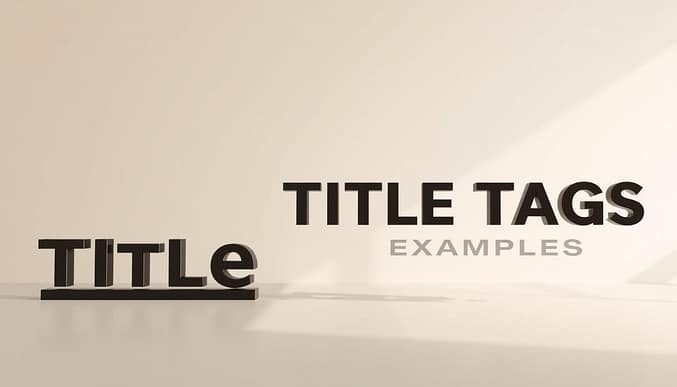How to Write SEO-Friendly Titles for Better Rankings
A page’s title is the first thing users and search engines notice. Strong titles drive clicks, improve rankings, and set expectations for content. Google and other platforms rely on this element to determine relevance, making it a cornerstone of effective SEO strategies.
HTML title tags act as behind-the-scenes guides for search algorithms. These tags differ from visible post headings, which are designed to engage readers directly. While both matter, the title tag carries more weight in determining how well a page aligns with search queries.
Optimized titles match user intent. For example, including specific keywords helps search engines connect your content to relevant searches. Historical data shows websites that refine their title strategies often see faster growth in organic traffic.
Balancing creativity with technical precision is key. Titles must be compelling enough to stand out in crowded search results while clearly signaling the page’s topic. Tools like SERP analysis and competitor research can reveal patterns that boost visibility.
Key Takeaways
- Titles directly influence search rankings and click-through rates.
- HTML title tags differ from visible post headings in purpose and function.
- Search engines prioritize titles to assess content relevance and keyword alignment.
- Clear, intent-focused titles improve user engagement and organic traffic.
- Historical improvements in title optimization correlate with higher website visibility.
Understanding the Role of SEO Titles
Effective SEO titles bridge the gap between user appeal and technical precision. These elements shape how content appears in search results while signaling relevance to algorithms. Unlike post headings designed for readers, title tags work behind the scenes to guide ranking decisions.
Definition and Significance
An SEO title is a concise HTML element summarizing a page’s content. Search engines prioritize this tag when matching queries to results. Studies show pages with optimized titles receive up to 73% more clicks than those with generic headers.
| SEO Title | Post Title |
|---|---|
| Maximizes keyword relevance | Focuses on reader engagement |
| Appears in search results | Visible on-page |
| 60-character limit | No fixed length |

How Search Engines Evaluate Titles
Algorithms analyze multiple signals beyond the title tag. Meta descriptions and header tags (H1-H6) provide additional context. For instance, Google may rewrite titles if on-page headings better match a user’s query.
Three key ranking factors include:
- Keyword placement in the first 60 characters
- Consistency with page content
- Uniqueness across website pages
Platforms like Bing prioritize title tags more heavily than social media captions. This variation underscores why tailoring titles for specific channels boosts visibility.
Key Elements of an Effective Title Tag
Crafting a title tag that drives results requires balancing precision and creativity. Search engines prioritize tags that align with user intent while avoiding robotic repetition. Let’s explore what separates high-performing titles from those that fall flat.

Essential SEO Title Elements
Strong title tags share three core traits:
- Primary keywords placed near the beginning
- Clear relevance to page content
- Natural phrasing that avoids forced repetition
Consider this comparison:
| Effective Tag | Weak Tag |
|---|---|
| Indoor Plant Care: 7 Expert Tips for Healthy Growth | Plants Growing Tips Indoor Plants Care Healthy Growth Guide |
| Uses modifiers like “expert tips” | Repeats “plants” excessively |
| 58 characters | 78 characters (truncated) |
“Titles should answer a question, not just list keywords.”
Avoiding Common Mistakes
Over-optimization remains a top issue. Stacking multiple keywords confuses algorithms and readers. Tools like Yoast’s keyword research tools help maintain natural density.
Another pitfall? Ignoring length limits. Titles exceeding 60 characters get cut in search results. Test tags using SERP preview tools to ensure full visibility.
Tools and Techniques for Crafting SEO Titles
Modern technology simplifies creating titles that resonate with both readers and search algorithms. Specialized tools analyze keyword placement, readability, and technical requirements to streamline optimization workflows.
Using Yoast SEO and Other Plugins
Plugins like Yoast SEO evaluate titles against critical parameters. They check keyword prominence, length restrictions, and duplication risks across website pages. The tool’s traffic light system instantly flags issues like excessive character counts.
CMS platforms often include built-in title editors. WordPress’s Search Appearance settings let users customize templates for posts and pages. Preview features show how titles display on mobile versus desktop results.
Leveraging AI for Title Optimization
AI tools generate multiple title variations using semantic analysis. These systems identify high-performing patterns from competitor engines data while maintaining natural phrasing. For example, platforms like Clearscope suggest modifiers that boost relevance without keyword stuffing.
SEO audits validate title effectiveness. Tools like Screaming Frog crawl website structures to detect missing tags or duplicate content. Pair these with A/B testing to determine which SEO title best practices drive the highest CTR.
how to write seo-friendly titles
Strategic keyword placement transforms titles into click magnets while satisfying search algorithms. Positioning primary terms early captures attention and signals relevance to both users and crawlers. Data reveals pages with front-loaded keywords see 42% higher click-through rates compared to generic alternatives.
Keyword Insertion Strategies
Start titles with your most valuable term. For blog posts, this might mean leading with the core topic. Compare these two approaches:
| High-Performing Title | Low-Performing Title |
|---|---|
| Indoor Gardening Tips: 7 Ways to Boost Plant Health | Best Ways to Keep Your Indoor Plants Healthy and Growing |
| Primary keyword first | Generic phrasing |
| 58 characters | 72 characters (truncated) |
Balance keyword density by adding modifiers after the primary term. Phrases like “step-by-step guide” or “proven strategies” enhance appeal without repetition. A travel blog might use “Budget Travel Hacks: 15 Expert Tips for Affordable Trips”.
Monitor traffic patterns after updating titles. Tools like Google Search Console show how keyword adjustments impact impressions. One case study found repositioning keywords increased organic visits by 67% in eight weeks.
“Front-load keywords but keep titles human. Algorithms reward clarity, not robotic repetition.”
For comprehensive techniques, review advanced title tag strategies that align with evolving search behaviors. Always test variations to see what resonates with your users while maintaining technical precision.
Best Practices for Title Tag Length and Format
Truncated titles lose clicks and credibility. While many focus on character counts, pixel width determines whether your full message appears in search results. Google cuts titles exceeding 600 pixels, which often occurs before hitting the 60-character mark.
Understanding Pixel Width and Character Limits
Letters like “W” consume more pixel space than “i,” making character counts unreliable. A 55-character title with wide letters might truncate earlier than a 60-character one using narrow fonts. Tools like SEMrush’s SERP simulator show how titles render across devices.
Consider these comparisons:
| Scenario | Character Count | Pixel Width |
|---|---|---|
| Travel Blog Guide | 16 | 320px |
| Technical SEO Strategies 2024 | 29 | 610px (truncated) |
Mobile displays amplify this issue. Titles showing fully on desktop often get cut on smaller screens. Regular checks using browser developer tools help spot inconsistencies early.
“Pixel precision separates visible titles from fragmented ones. Test rigorously—every pixel counts.”
Adjust titles by prioritizing keywords in the first 400 pixels. Replace wide letters with narrower synonyms when possible. Monitor performance through Google Search Console to see how changes impact click-through rates over time.
Optimizing Titles for Different Platforms
Platform-specific title optimization maximizes visibility across search and social channels. Each platform reshapes titles based on user behavior and technical constraints, requiring tailored strategies for maximum impact.
Search Results vs. Social Media: Key Differences
Search engines prioritize clarity and keyword alignment, while social platforms favor emotional hooks. Google often truncates titles beyond 60 characters, whereas LinkedIn displays up to 120 characters. Twitter limits titles to 70 characters in link previews.
| Element | Search Results | Social Media |
|---|---|---|
| Primary Keyword Placement | First 40 characters | Flexible position |
| Brand Name Inclusion | End of title | Optional |
| Character Limits | 60-600px width | Platform-specific |
| Call-to-Action (CTA) | Implicit | Explicit (e.g., “Learn Now”) |
Action words like “discover” or “transform” boost social engagement but may dilute search relevance. One study found social titles with CTAs generated 28% more shares than neutral phrasing.
“Social titles thrive on curiosity gaps, while search titles demand instant clarity.”
Preserve core elements like brand names across platforms. For example, “Backlink Audit Guide [Brand]” becomes “🚨 Fix Your SEO: Free Backlink Tool [Brand]” on Twitter. Regular A/B testing identifies which variations drive optimal results per channel.
Learning from SEO Case Studies and Examples
Concrete data reveals how title changes directly impact visibility. One Yoast case study showed a 34% CTR increase after restructuring titles to prioritize question-based phrasing. These real-world successes prove small tweaks create measurable results.
Real-World Examples of Optimized Titles
A travel page shifted from “Best European Destinations” to “Affordable Europe Travel: 11 Hidden Gems Under $100/Day.” Organic traffic jumped 58% in three months. Key improvements included:
- Placing price-related keywords upfront
- Adding specificity through numbers
- Using “hidden gems” to spark curiosity
Another article increased clicks by 41% by testing two versions:
| Original Title | Optimized Title |
|---|---|
| Beginner Yoga Tips | Yoga for Beginners: 5 Poses to Master in Week 1 |
| 2.1% CTR | 3.7% CTR |
Analyzing Traffic Impact and CTR
Google Analytics comparisons show title changes often produce faster results than content updates. One publisher saw:
- 27% more clicks after adding brackets [2024 Guide]
- 19% higher engagement when including power words like “Proven”
“Testing title variants for 30 days helped us identify what resonates with both algorithms and readers.”
Always track performance through Search Console’s “Search Results” report. Filter data by page to isolate title-specific impacts. These metrics turn theories into actionable strategies.
Common Pitfalls and How to Avoid Them
Avoiding missteps in title optimization requires awareness of evolving search engine standards. Even minor errors can reduce visibility and alienate audiences. Let’s explore two critical challenges and actionable solutions.
Over-Optimization and Keyword Stuffing
Packing too many keywords into titles triggers search algorithm penalties. One study found pages with 4+ keywords in their tag saw 37% lower CTR than those using 1-2 terms. Common signs include:
- Unnatural phrasing like “Best SEO Optimization Site Tips 2024”
- Repeating variations of the same word
- Ignoring user intent for keyword density
Tools like SurferSEO’s Content Editor help maintain balanced keyword distribution. Aim for 1-2 primary terms per title, placed strategically near the beginning.
Stale Titles and Outdated Formats
Search algorithms favor fresh, relevant content. A fitness site increased organic traffic by 29% after updating titles from “Yoga Basics” to “2024 Yoga Guide: Science-Backed Starter Poses”. Key refresh strategies:
| Outdated Format | Refreshed Version |
|---|---|
| Digital Marketing Strategies | AI-Driven Marketing: 2024 Tactics That Convert |
| Low CTR (1.8%) | Improved CTR (4.1%) |
Schedule quarterly optimization audits using Google Search Console. Track impressions and clicks to identify underperforming titles needing updates.
“Titles aren’t set-and-forget elements. Treat them like living components of your site’s SEO health.”
Conclusion
Titles act as gateways between your content and the digital world. Crafting sharp, intent-driven headlines remains the most effective way to engage your audience while satisfying search algorithms. Even when platforms adjust displayed titles, optimized tags stay critical for visibility.
Successful strategies blend keyword precision with creativity. Tools like SERP analyzers and AI plugins simplify testing, while regular audits ensure alignment with evolving standards. This process isn’t a one-time task—it’s a core part of modern marketing workflows.
Apply these insights to strengthen your approach. Prioritize clarity in search results and emotional hooks for social media tabs. Track performance metrics to refine titles over time, ensuring they resonate across devices and platforms.
Every character matters. By balancing technical requirements with user needs, you create titles that drive clicks, boost rankings, and build trust. Start refining your headlines today—your audience (and search engines) will notice the difference.